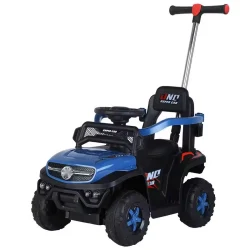Uses of Toy Cars and Vehicles
2024-05-30
Toy cars and vehicles are miniature replicas of real automobiles and transportation vehicles, designed for play and enjoyment by children and collectors alike. These toys come in various styles, sizes, and materials, offering a wide range of options for imaginative play, collection, and display. Here's an overview of toy cars and vehicles, including their types, uses, and considerations for choosing the right ones:
Types of Toy Cars and Vehicles
1. Die-cast Cars:
- Made from metal alloy (typically zinc) and featuring intricate details and realistic designs.
- Available in various scales, from small pocket-sized models to larger collectible replicas.
2. Plastic Cars:
- Made from durable plastic materials, often with simpler designs and bright colors.
- Lightweight and suitable for younger children due to their safety and durability.
3. Remote-Controlled (RC) Cars:
- Powered by electric motors and controlled remotely using a radio transmitter.
- Offer features such as forward/backward movement, turning, and sometimes even lights and sounds.
4. Model Kits:
- DIY assembly kits that allow enthusiasts to build and customize their own miniature cars and vehicles.
- Available in various skill levels, from beginner to advanced, and often come with painting and detailing options.
5. Wooden Cars:
- Handcrafted toy cars made from wood, often featuring simple, timeless designs.
- Environmentally friendly and suitable for young children due to their natural materials.
6. Pull-Back Cars:
- Mechanically powered toys that move forward when pulled back and released.
- Offer simple and engaging play for children, with no batteries or remote control required.
7. Collectible Cars:
- High-quality replicas of classic or vintage cars, often made from die-cast metal or resin.
- Sought after by collectors for their detailed craftsmanship and historical significance.
Uses of Toy Cars and Vehicles
1. Imaginative Play:
- Provide children with opportunities for imaginative role-playing, storytelling, and creative exploration.
- Encourage the development of fine motor skills, hand-eye coordination, and spatial awareness.
2. Education:
- Introduce children to concepts such as vehicle types, colors, numbers, and basic physics principles (e.g., motion, friction).
- Enhance cognitive skills through sorting, categorizing, and organizing different types of vehicles.
3. Collecting and Display:
- Serve as collectible items for enthusiasts interested in cars, trucks, motorcycles, or specific brands and models.
- Displayed in collections, dioramas, or on shelves as decorative pieces or conversation starters.
4. Outdoor and Indoor Play:
- Suitable for both indoor and outdoor play, offering versatility and entertainment in various settings.
- Provide opportunities for social interaction and cooperative play when shared with friends or siblings.
5. Therapeutic Play:
- Used as therapeutic tools for children with special needs or sensory processing challenges, promoting relaxation and sensory stimulation.
- Offer calming and soothing effects through repetitive motions and tactile engagement.
Considerations for Choosing Toy Cars and Vehicles
1. Age Appropriateness:
- Consider the recommended age range for the toy, ensuring it is safe and suitable for the child's developmental stage.
2. Durability and Safety:
- Choose toys made from high-quality, non-toxic materials that can withstand rough play and frequent handling.
- Check for rounded edges, sturdy construction, and adherence to safety standards.
3. Interactivity:
- Select toys with interactive features such as lights, sounds, or moving parts to enhance engagement and play value.
4. Theme and Interest:
- Consider the child's interests, preferences, and favorite vehicle types (e.g., cars, trucks, planes) when choosing the design or theme of the toy.
5. Scale and Size:
- Choose toy cars and vehicles in appropriate scales and sizes for compatibility with other toys or collectible sets.
- Consider storage space and portability when selecting larger or bulkier items.
6. Budget:
- Determine your budget and choose toys that offer the best value for money while meeting your quality and durability requirements.
Conclusion
Toy cars and vehicles offer endless possibilities for play, learning, and enjoyment for children of all ages. Whether it's for imaginative play, education, collecting, or therapeutic purposes, these toys stimulate creativity, encourage exploration, and provide hours of entertainment. By considering factors such as age appropriateness, durability, interactivity, and theme, you can choose the right toy cars and vehicles to suit your child's interests and preferences, fostering fun and enriching play experiences.



